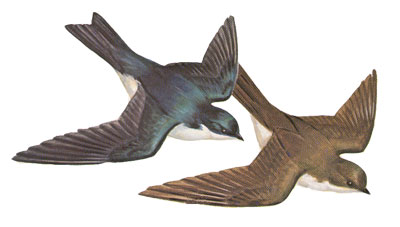

Vol. 14 No. 2
In this issue...
Reflections from the President
GINLC Involves Local Citizens in Water Monitoring
New Members Join the GINLC Board
Fundraiser Consultant Helps Steer Efforts
14th Annual Meeting Saturday, November 4 10AM
Did You Know?
Upcoming Events...
November
4
Annual Meeting
10:00AM
- Noon
Centennial Farm
Nature Area Open
Saturday 10:00AM
- 2:00PM
Thursday 6PM - 8PM
through end of August then
Thursday 5PM - 7PM
Closed during inclement weather
Last Day Open - October 28
Did
you Know …?
Items borrowed
from Birds of Michigan Field Guide by Stan Tekiela
and A Field Guide to Birds East of the Rockies by R. T. Peterson
 |
|
|
Size: 5-6" (13-15 cm)
Male:
Blue green in the spring and greener in fall. Appears to change color
in direct sunlight. A white belly, a notched tail and pointed wing tips
Female: similar to male, only duller
Juvenile: gray brown with a white belly and grayish breast band
Nest: cavity; female and male line former woodpecker cavity or nest box; 1 brood per year
Eggs: 4-6; white without markings
Incubation: 13-16 days; female incubates
Fledgling: 20-24 days; female and male feed young
Migration: complete; to Mexico and Central America
Food: insects
Compare: Similar color as Purple Martin, but smaller with a white breast and belly The Barn Swallow has a rust belly, and deeply forked tail.
Stans's
Notes: The first swallow species to return each spring. Most
common along ponds, lakes and agricultural fields. Is attracted to your
yard with nesting boxes. Travels great distances to find dropped feathers
to line its grass nest. Sometimes seen playing, chasing after dropped
feathers. Often seen flying back and forth across fields, feeding on insects.
Gathers in large flocks to migrate.
